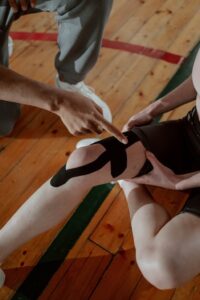Inside knee pain is a common complaint that affects many people, especially those who participate in sports or physical activities that put stress on the knee joint. This type of pain can be caused by a variety of factors, including overuse, injury, and underlying medical conditions such as arthritis and it is important to understand the underlying cause to determine the appropriate treatment.
One of the most common causes of inside knee pain is a medial collateral ligament (MCL) injury. The MCL is the ligament that runs along the inner side of the knee joint and provides stability to the knee. Injuries to this ligament can cause pain on the inside of the knee, along with swelling and stiffness.
Another common cause of inside knee pain is a meniscal tear. The meniscus is a cushioning cartilage in the knee joint that helps to absorb shock. Tears in the meniscus can cause pain on the inside of the knee, along with a popping or clicking sensation.
Osteoarthritis is another cause of inside knee pain. This degenerative joint disease causes the cartilage to wear away, leading to pain and stiffness in the knee joint. Patellofemoral pain syndrome, bursitis, and tendinitis can also cause pain on the inside of the knee.
If you are experiencing persistent or severe inside knee pain recommend the appropriate treatment. Treatment options may include rest, ice, compression, elevation, physical therapy, or medication. In some cases, surgery may be necessary to repair or remove damaged tissue.
Here are some home remedies that may help alleviate inner knee pain:
1. Rest and Ice: Resting the affected knee and applying ice to the area can help reduce inflammation and relieve pain. Apply ice to the inner knee for 20-30 minutes several times a day.
2. Compression: Applying compression to the knee with an elastic bandage or brace can help reduce swelling and provide support.
3. Elevation: Elevating the affected knee above heart level can also help reduce swelling and inflammation.
4. Gentle Stretching: Gentle stretching and range-of-motion exercises can help improve flexibility and reduce stiffness in the knee. However, avoid any movements that cause pain or discomfort.
5. Heat therapy: Applying heat to the inner knee can help increase blood flow and promote healing. Use a heating pad, warm towel or take a warm bath.
6. Weight loss: If you are overweight, losing weight can help reduce the load on your knee joints and alleviate pain.
7. Turmeric: Turmeric contains an active ingredient called curcumin, which has anti-inflammatory properties. Adding turmeric to your diet or taking turmeric supplements may help reduce inflammation in the knee joint.
In
addition to home remedies, there are other treatments that can help alleviate
inner knee pain. Here are some options.
Physical Therapy: A physical therapist can help develop
a personalized exercise program to improve strength, flexibility, and
range of motion in the knee joint. They may also use techniques like
manual therapy, massage, and ultrasound to reduce pain and inflammation.
Medications: Over-the-counter pain relievers like
acetaminophen and ibuprofen can help reduce pain and inflammation. Your
doctor may also prescribe stronger medications if necessary.
Injections: Corticosteroid injections into the knee
joint can help reduce inflammation and pain. Hyaluronic acid injections
can also help lubricate the joint and improve mobility.
Surgery: If other treatments do not alleviate the pain,
surgery may be necessary. Common procedures include arthroscopy, in which
a small camera is inserted into the knee to remove damaged tissue, or knee
replacement surgery, in which the damaged joint is replaced with an
artificial one.
Exercises for inner knee pain:While not all causes of inner knee pain are preventable, doctors and physical therapists recognize strengthening the leg muscles, specifically the quadriceps and hamstrings, as one of the most effective ways to treat and prevent knee injury. According to a 2008 study from the University of Minnesota’s department of orthopedic surgery, helpful exercises include:
* straight leg lifts
* leg presses
* mini squats
* stationary or recumbent biking
* Swimming
* walking or running on an elliptical machine
* leg extensions
In addition, you should always begin and end exercising of any kind by stretching all the muscles involved, especially the quadriceps and hamstrings. Check out these quad and hamstring exercises to strengthen bad knees.
In conclusion, knee pain can be caused by a variety of factors, and it is essential to seek medical attention if you experience persistent or severe pain. Understanding the underlying cause of the pain is essential to determine the appropriate treatment and prevent further damage to the knee joint.
